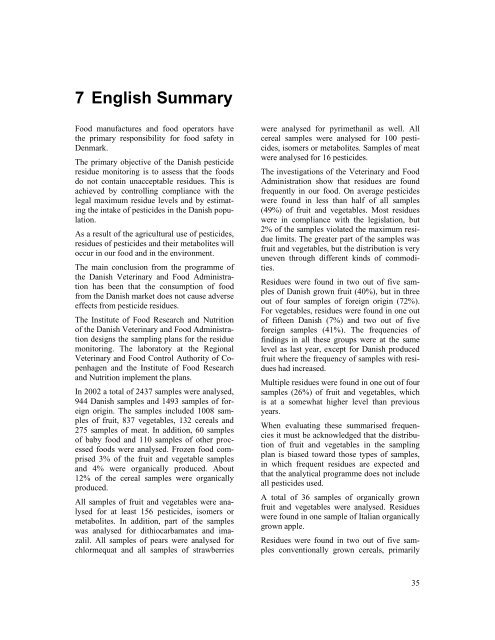Pesticidrester i fødevarer 2002
Pesticidrester i fødevarer 2002
Pesticidrester i fødevarer 2002
Create successful ePaper yourself
Turn your PDF publications into a flip-book with our unique Google optimized e-Paper software.
7 English Summary<br />
Food manufactures and food operators have<br />
the primary responsibility for food safety in<br />
Denmark.<br />
The primary objective of the Danish pesticide<br />
residue monitoring is to assess that the foods<br />
do not contain unacceptable residues. This is<br />
achieved by controlling compliance with the<br />
legal maximum residue levels and by estimating<br />
the intake of pesticides in the Danish population.<br />
As a result of the agricultural use of pesticides,<br />
residues of pesticides and their metabolites will<br />
occur in our food and in the environment.<br />
The main conclusion from the programme of<br />
the Danish Veterinary and Food Administration<br />
has been that the consumption of food<br />
from the Danish market does not cause adverse<br />
effects from pesticide residues.<br />
The Institute of Food Research and Nutrition<br />
of the Danish Veterinary and Food Administration<br />
designs the sampling plans for the residue<br />
monitoring. The laboratory at the Regional<br />
Veterinary and Food Control Authority of Copenhagen<br />
and the Institute of Food Research<br />
and Nutrition implement the plans.<br />
In <strong>2002</strong> a total of 2437 samples were analysed,<br />
944Danishsamplesand1493samplesofforeign<br />
origin. The samples included 1008 samples<br />
of fruit, 837 vegetables, 132 cereals and<br />
275 samples of meat. In addition, 60 samples<br />
of baby food and 110 samples of other processed<br />
foods were analysed. Frozen food comprised<br />
3% of the fruit and vegetable samples<br />
and 4% were organically produced. About<br />
12% of the cereal samples were organically<br />
produced.<br />
All samples of fruit and vegetables were analysed<br />
for at least 156 pesticides, isomers or<br />
metabolites. In addition, part of the samples<br />
was analysed for dithiocarbamates and imazalil.<br />
All samples of pears were analysed for<br />
chlormequat and all samples of strawberries<br />
were analysed for pyrimethanil as well. All<br />
cereal samples were analysed for 100 pesticides,<br />
isomers or metabolites. Samples of meat<br />
were analysed for 16 pesticides.<br />
The investigations of the Veterinary and Food<br />
Administration show that residues are found<br />
frequently in our food. On average pesticides<br />
were found in less than half of all samples<br />
(49%) of fruit and vegetables. Most residues<br />
were in compliance with the legislation, but<br />
2% of the samples violated the maximum residue<br />
limits. The greater part of the samples was<br />
fruit and vegetables, but the distribution is very<br />
uneven through different kinds of commodities.<br />
Residues were found in two out of five samples<br />
of Danish grown fruit (40%), but in three<br />
out of four samples of foreign origin (72%).<br />
For vegetables, residues were found in one out<br />
of fifteen Danish (7%) and two out of five<br />
foreign samples (41%). The frequencies of<br />
findings in all these groups were at the same<br />
level as last year, except for Danish produced<br />
fruit where the frequency of samples with residues<br />
had increased.<br />
Multiple residues were found in one out of four<br />
samples (26%) of fruit and vegetables, which<br />
is at a somewhat higher level than previous<br />
years.<br />
When evaluating these summarised frequencies<br />
it must be acknowledged that the distribution<br />
of fruit and vegetables in the sampling<br />
plan is biased toward those types of samples,<br />
in which frequent residues are expected and<br />
that the analytical programme does not include<br />
all pesticides used.<br />
A total of 36 samples of organically grown<br />
fruit and vegetables were analysed. Residues<br />
were found in one sample of Italian organically<br />
grown apple.<br />
Residues were found in two out of five samples<br />
conventionally grown cereals, primarily<br />
35
















